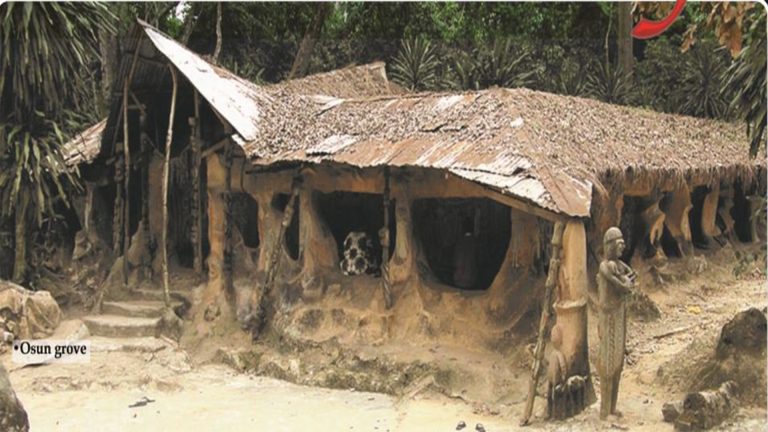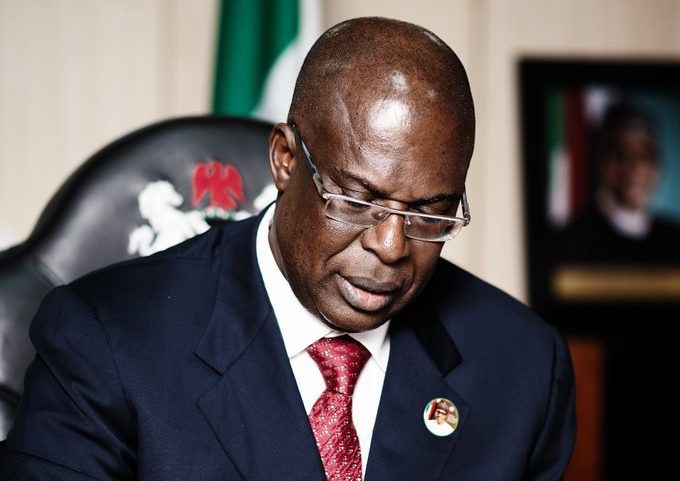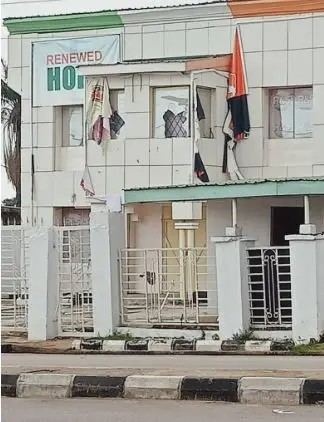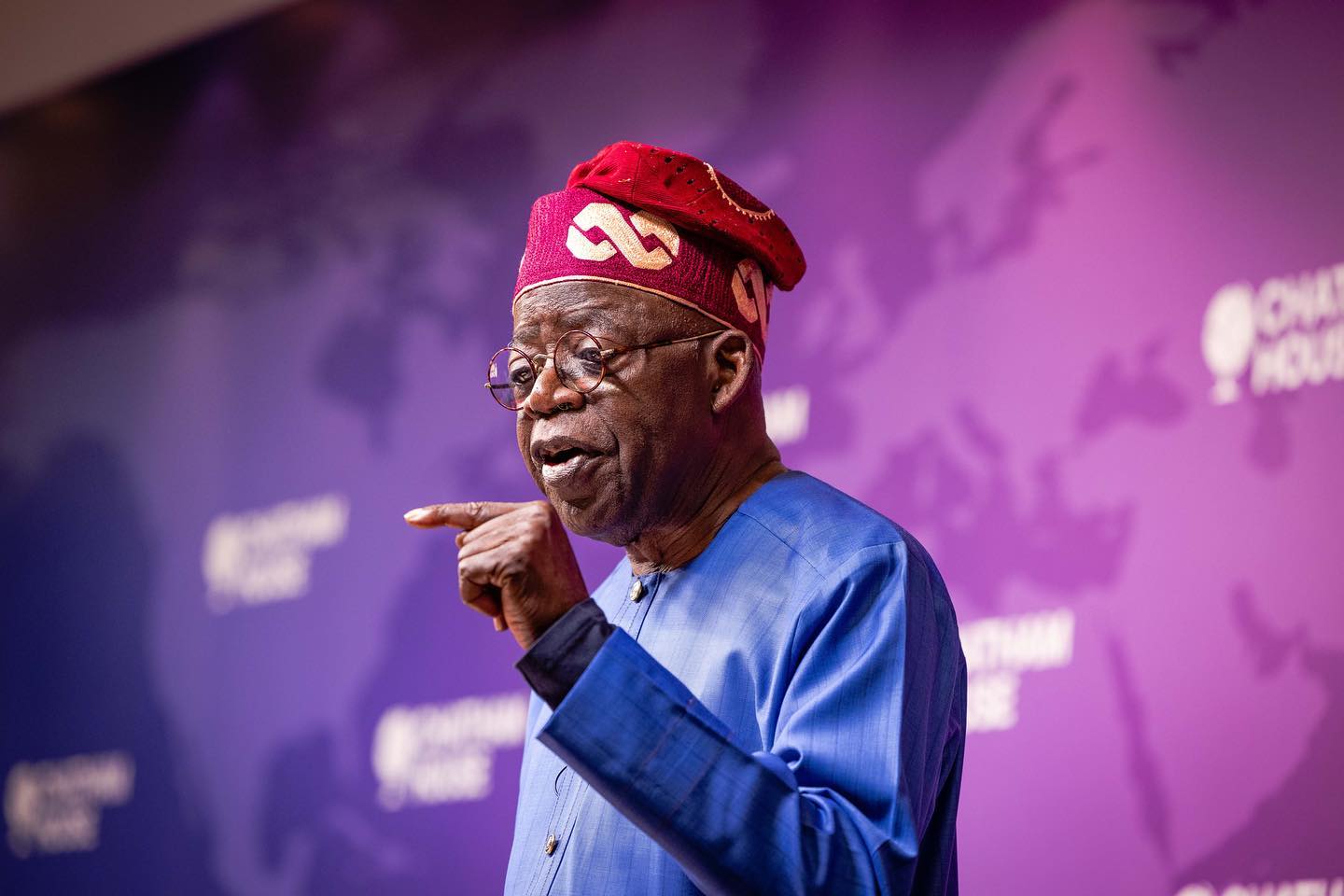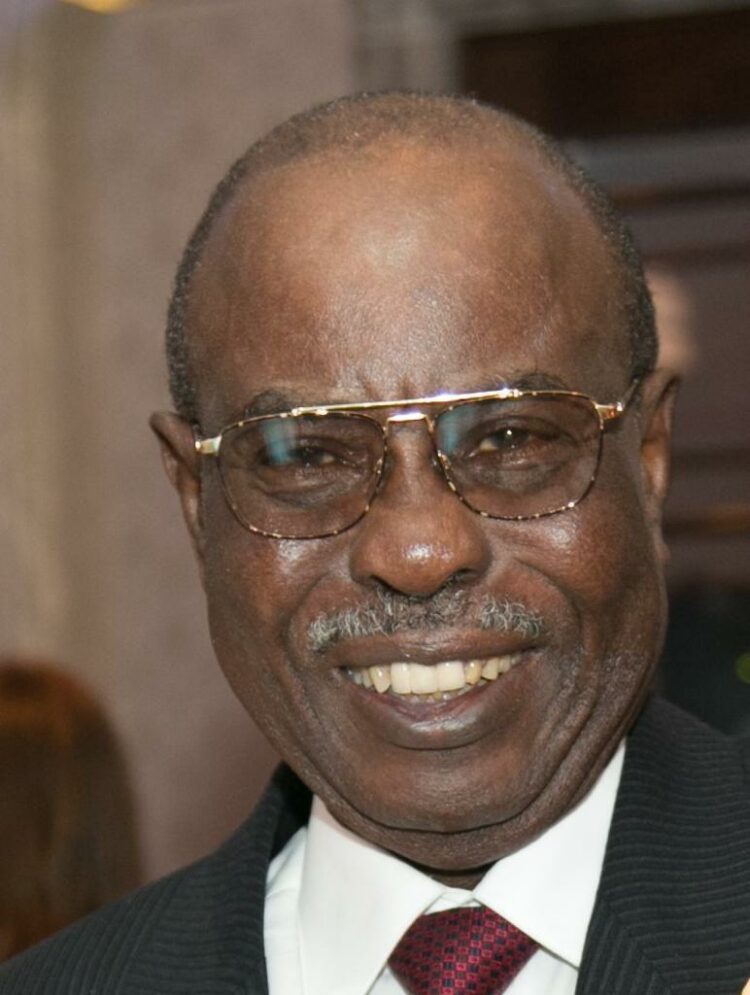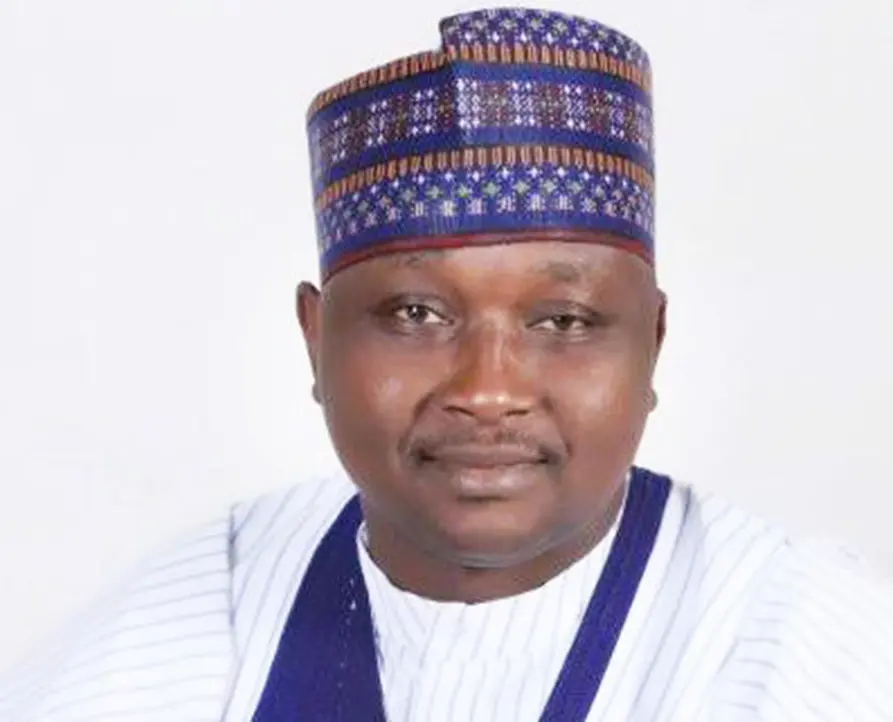The ancient city of Osogbo is in the spotlight over the alleged disappearance of Osun deity. SINA FADARE, who visited the city, reports that there is more to the issue than meets the eye.
THE controversy generated by the alleged sale of Osun goddess is compounded by the recent removal of the Baba Osun and the Iya Osun, the male and female custodians of the deity, allegedly by the Ataoja of Osogbo, Oba Jimoh Olanipekun.
Chief Adigun Olayiwola Olosun, the man who blew the whistle over the sacrilegious act, had alleged that the missing deity was sold to some people. His allegation followed a call he claimed to have received from a man in Lomé, Togo, confessing that they bought the goddess from a tall woman called Iya Osun in alleged active connivance with Oba Olanipekun, in the sum of N15 million.
The call, Adigun said, was necessitated by the difficulty those who took the deity away were having in putting it in the aircraft that would fly it to Europe where it was billed for sale. In the bid to get out of the quagmire, their accomplices in Osogbo had to avail the buyers with Adigun’s phone number so they could contact him for possible solution, particularly as the goddess was said to have become angry, appearing to them in dreams and demanding that she be returned to the Osun temple.
In a bid to retrieve the deity, Adigun agreed to meet with the caller from Togo in Ibadan, where it was revealed that the deal was allegedly masterminded by the ousted Arugba (the deity’s calabash bearer). Thereafter, he took possession of the deity after their N15 million was refunded.
But speaking with our correspondent in his palace, Oba Olanipekun dismissed Adigun as a jester who did not know what he was talking about.
According to him, the Ataoja (the Oba himself) and the Osun deity are inseparable entities like Siamese twins, adding that his title has its origin in the Osun deity, hence nobody can sell it.
He said: “Osun is a spirit. She only makes herself available to those she chooses to see. And if anybody dares her, she will prove her spiritual superiority. “After my great grandfather, Laro, had settled at the base of the river when they arrived from lpole, Osun came out in form of a pretty woman and presented a big fish to Laro as a symbol of an agreement she had with them that they should move a bit far away from the river bank, and there would be a covenant between her and Laro’s people.
“As part of the process of getting the big fish from Osun, Atewo Gbeja (the fish receiver) became the title of any Oba in Osogbo till today. It was Atewo Gbeja that was eventually pronounced as Ataoja.”
Historical antecedent
Efforts to dig further into the alleged sale of Osun deity revealed the complexity of the story of the deity itself. A lot of loopholes and unanswered questions make the situation more complex. Unlike other notable gods in Yoruba land like Ogun (the god of Iron) or Sango (the god of thunder), whose symbol can be moved from one place to the other depending on where the priest resides, the origin of Osun Osogbo presents a completely different scenario.
According to the Araba of Osogbo land, Chief Yemi Osundagbonu Elebui bon, the Osun goddess was based in a river where the settlers, Timehin, a powerful hunter, and Laro came from lpole to settle because of water scarcity.
He said: “It was Timehin, a great hunter, who went to Ipole to announce the discovery of a big river where the people could settle and make a living. In every dry season, the people usually experienced scarcity of drinking water. He, therefore, invited the people to come and settle close to the river.
“Osun is the owner of Osogbo. Olutimehin and Laro, who were the first settlers in Osogbo, met Osun on ground. When they wanted to settle very close to the river, Osun told them that a spirit and human beings could not leave together.

“The people decided to start a living very close to the river. One day, while they were cutting some trees to make a home, one of the trees fell into the river. Immediately the tree fell inside the river, a voice came from the river saying, ‘Oso ile, aje ile won ti fo gbogbo ikoko aro mi’, meaning all the witches and wizards in the jungle have destroyed my dye pots.
“After this strange voice, Timehin, who was a brave hunter, put on his war regalia and entered the river. He saw Osun inside the river and narrated their predicament to Osun and why they came to settle in the area.”
According to the Araba of Osogbo, “the Osun goddess told Timehin that they could not live together with her because they were human beings and she was a spirit. But she told them that they should move forward until they got to three hills where they could settle.
“The first hill they saw was Oke Ohuntoto now in Osun forest. The second one was Jamegbon and the third one was where the Central Mosque is built today. That was how the two families, Laro and Timehin, settled down.
“Meanwhile, Timehin came with a calf from the jungle to domicile in his compound. That was why up till today, the Timehin household is referred to as Omo a merin wa telu. That is, someone who brought in an elephant to domicile in the town.
“Osun told them that she would always assist them and both would live in harmony.
“When the Fulani army wanted to invade Osogbo to launch an attack on Oyo Empire, it was Osun who saved them. It was Osun who came out like a pretty woman, prepared egbo and gbegiri soup and gave it to Ilorin warriors who were stationed at the entrance of the town with a view to overrunning the town during the night.
“After eating the food, they all died. That single act was the point of agreement between Osun and the Ataoja of Osogbo who usually visits the river as a symbol of appreciation.
“How then can we separate Osun from Osogbo? It is not possible. It was Osun who did not allow war to ravage the town, and she also gave children to the barren. So, there is no way we can separate Osun from Osogbo.”
Genesis of crisis
The Nation investigation revealed that since Adigun was relieved of his position as the Baba Olosun, a position he had allegedly used to his advantage, especially in Germany where he resided, things have not remained the same.
It was gathered that the Ataoja had to take a drastic action in order to restore sanity to the traditional temple. It was alleged that the son of the Iya Osun, Ayo Kolade, invited his wife to live with him at the Osun temple, a step the Ataoja said was a sacrilege. All efforts to make Kolade see reason was said to have proved futile.
Against this backdrop, the Ataoja was said to have instructed the chiefs to eject him and his wife from the temple; a situation the mother, Adesiyan Olayiwola (lya Olosun), was not happy with. Hence, she packed her belongings and left the temple.
Providing the background to the feud, the Ajagunna of Osogbo, Chief Gabriel Oparanti, said: “The Ataoja did not remove the lya Osun and the Baba Osun; they removed themselves. The Ataoja asked Ayo Kolade, who was living with his wife in Osun House, to move out because it was a taboo for husband and wife to live together in the place. But when he disobeyed, the Ataoja told us that we, the Chiefs of Osogbo land, should instruct him to vacate the Osun House.”
Ajagunna noted that when Kolade refused to move out, her mother was invited. “We invited Iya Osun and informed her that the Ataoja wanted her son to vacate the Osun House, which was formerly the Ataoja palace, because he disrespected the King.
“But the Iya Osun said that if her son must vacate the place, she too would leave. We told her that she needed not to leave the place. What we saw next was that they came with two tricycles to pack their belongings from the Osun House. According to Oparanti, the Baba Osun and the Iya Osun hail from the same family, implying that Ayo Kolade is related to the Baba Osun. “That was why the Baba Osun too decided to leave, prompting the Ataoja to appoint new Baba Osun and Iya Osun.” However, Oyetunji, went into the background to Layi Adigun’s history, saying that he was not appointed by anybody to become the Baba Olosun. According to him, “Laro’s wife was the first Iya Osun.
She was the one who followed the Arugba to the river. Since then, it is the wife of the Oba that usually performs that function. The Osun deity is my property and anybody that is so blessed by the goddess can worship it. “Osun is a spirit and I am her symbol. Everybody follows me to the river every year to offer sacrifice and supplication. Nobody ever gave Layi (Adigun) or his father the traditional title of Baba Olosun. The Ataoja only has Baba Orisa, because he has many gods like Oro, Ogun and Ifa, apart from the Osun goddess. “The Ataoja used to appease all these gods. So, we have Baba Oloosa, not Baba Olosun.
The Ataoja is the owner and symbol of Osun, and no one else. Nobody can sell my Osun deity, because it is a spirit which you cannot see with the naked eye unless you are an Ataoja.” According to him, “The man called Layi Adigun, who alleged that the Osun deity had been stolen, does not have any connection with Osun. Osun assisted his father in the past and he leveraged on this to attach himself with Osun devotee. His father came from Otan Ayegbaju.
He was a bricklayer. “According to Adigun himself, he claimed that there was a time he was kidnapped and suddenly remembered the Osun goddess which his father was worshipping and he cried to her to save him. “He said he saw a woman with a special bead like Iya Osun who suddenly appeared at the scene and took him away. He said he later found himself at the Osun shrine and did not know where he was until passers-by recognised him and took him to Ataoja’s palace. “When he got to Ataoja ‘s palace, he told everybody what he saw, and since then, he has been attached to Osun worshippers.”
The royal father explained that Adigun’s father used the Osun goddess as a means of survival many years ago. He said: “He had a statue then called ‘Jubilee, which he used to carry about, collecting money from the people. Children usually followed him. We used to give the old man one penny in those days as a small boy.
He used that method to eat and claimed to be a devotee of Osun goddess.” Can Osun goddess be sold? Adigun, who claimed to be the CEO of lya Dudu Centre for Yoruba Arts and Culture in Germany, insisted that he had the custody of the said Osun deity that was allegedly sold, though he could not present it to anybody to see. He argued, “If the lrele in lkirun and the Otin in Okuku can be sold, what stopped fraudsters from selling Osun? They did.” But the Ataoja of Osogbo insisted that Adigun was out of his mind and did not
know what he was saying. He said: “Osun is a heritage which has been passing from one generation to the other. I have followed my fathers, the two past Ataojas, to the Osun groove when I was young. I used to celebrate everything with them. All that they were doing then were exactly what l am doing now.
“Layiwola Adigun is hungry. But he should not tarnish the good names of my forefathers which l hold in high esteem.” Corroborating the royal father, Chief Oparanti, the Ajagunna of Osogbo, said: “Nobody dares sell Osun deity. Anybody who dares to set an eye on it apart from the priest that is in custody of the Osun House will go blind. Therefore, we do not believe it because it is an unverified information. To Elebuibon, the sale of Osun deity is not possible. “It is a goddess that belongs to all. It cannot be stolen. Osun goddess is the only god we celebrate in Osogbo.
Osun Osogbo is a deity that has the origin and foundation of Osogbo. “The man who claimed that Osun deity has been sold is telling a lie, because it is not possible. If it was true, he should show a proof of how it was allegedly claimed back. l did my own independent investigation and l did not see any iota of truth in the claim that the deity has been sold.
“The throne of Ataoja of Osogbo has a lot to do with Osun goddess. There are some people who are into antiquity business but they are warned by government not to sell the core traditional ones.” With Elebuibon, the Araba of Osogbo and a renowned lfa priest and custodian of deities in the ancient town of Osogbo asserting that the Osun deity cannot be moved much less sold, there are many questions only Adigun could answer: where did Adigun keep the so- called Osun deity since he relocated to his base in Germany? Who gave him the title of Baba Osun he is currently claiming? How did he raise the N15 million allegedly paid to those who claimed to have bought the deity without informing any of the traditional chiefs in Osogbo? What will happen to the next Osun celebration if the deity has disappeared as claimed? The answers to these knotty questions are as complex as a riddle. But traditionalists insist that Osun deity cannot be seen with an ordinary eye, much less taken away by someone who is not a devotee.

